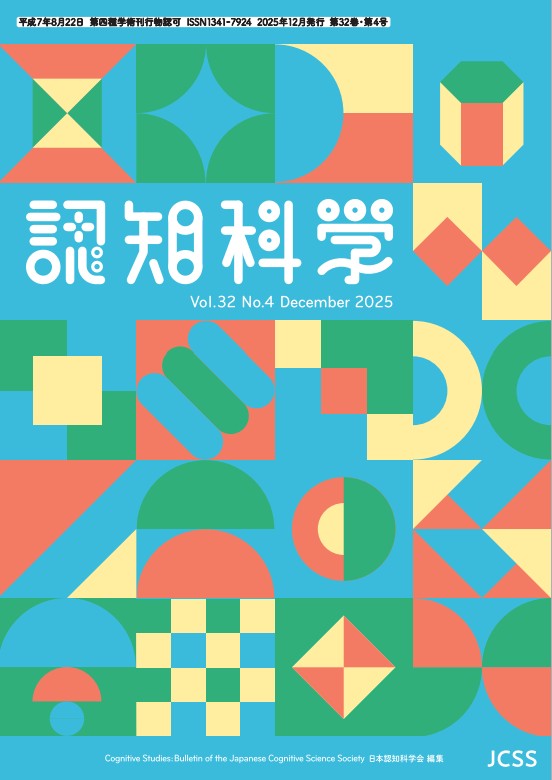Current issue
Cognitive studies: Bulletin of the Japanese Cognitive Science Society
Displaying 1-28 of 28 articles from this issue
- |<
- <
- 1
- >
- >|
Foreword
-
Article type: Foreword
2025Volume 32Issue 4 Pages 461-462
Published: December 01, 2025
Released on J-STAGE: December 15, 2025
Download PDF (158K)
Messages from Award Winners
-
Article type: Other
2025Volume 32Issue 4 Pages 463-464
Published: December 01, 2025
Released on J-STAGE: December 15, 2025
Download PDF (165K) -
Article type: Messages from Award Winners
2025Volume 32Issue 4 Pages 465-466
Published: December 01, 2025
Released on J-STAGE: December 15, 2025
Download PDF (1123K) -
Article type: Messages from Award Winners
2025Volume 32Issue 4 Pages 467-468
Published: December 01, 2025
Released on J-STAGE: December 15, 2025
Download PDF (447K) -
Article type: Messages from Award Winners
2025Volume 32Issue 4 Pages 469-470
Published: December 01, 2025
Released on J-STAGE: December 15, 2025
Download PDF (321K)
Research Papers
-
Article type: Research Paper
2025Volume 32Issue 4 Pages 471-485
Published: 2025
Released on J-STAGE: December 15, 2025
Advance online publication: September 15, 2025Download PDF (15125K) -
Article type: Research Paper
2025Volume 32Issue 4 Pages 486-498
Published: 2025
Released on J-STAGE: December 15, 2025
Advance online publication: September 15, 2025Download PDF (1888K) -
Article type: Research Paper
2025Volume 32Issue 4 Pages 499-513
Published: December 01, 2025
Released on J-STAGE: December 15, 2025
Download PDF (3503K) -
Article type: Research Paper
2025Volume 32Issue 4 Pages 514-529
Published: December 01, 2025
Released on J-STAGE: December 15, 2025
Download PDF (1896K) -
Article type: Research Paper
2025Volume 32Issue 4 Pages 530-542
Published: December 01, 2025
Released on J-STAGE: December 15, 2025
Download PDF (1079K)
Brief Articles
-
Article type: Brief Article
2025Volume 32Issue 4 Pages 543-547
Published: December 01, 2025
Released on J-STAGE: December 15, 2025
Download PDF (567K)
Debate Cognitive study on steering for "local" echo-chambers
-
Article type: Other
2025Volume 32Issue 4 Pages 548-551
Published: December 01, 2025
Released on J-STAGE: December 15, 2025
Download PDF (409K) -
Article type: Debate
2025Volume 32Issue 4 Pages 552-562
Published: December 01, 2025
Released on J-STAGE: December 15, 2025
Download PDF (4720K) -
Article type: Debate
2025Volume 32Issue 4 Pages 563-565
Published: December 01, 2025
Released on J-STAGE: December 15, 2025
Download PDF (219K) -
Article type: Debate
2025Volume 32Issue 4 Pages 566-568
Published: December 01, 2025
Released on J-STAGE: December 15, 2025
Download PDF (398K) -
Article type: Debate
2025Volume 32Issue 4 Pages 569-572
Published: December 01, 2025
Released on J-STAGE: December 15, 2025
Download PDF (370K) -
Article type: Debate
2025Volume 32Issue 4 Pages 573-576
Published: December 01, 2025
Released on J-STAGE: December 15, 2025
Download PDF (456K)
Featured Tutorials The connection between cognitive science and rehabilitation
-
Article type: Other
2025Volume 32Issue 4 Pages 577
Published: December 01, 2025
Released on J-STAGE: December 15, 2025
Download PDF (118K) -
Article type: Tutorial
2025Volume 32Issue 4 Pages 578-588
Published: December 01, 2025
Released on J-STAGE: December 15, 2025
Download PDF (607K) -
Article type: Tutorial
2025Volume 32Issue 4 Pages 589-597
Published: December 01, 2025
Released on J-STAGE: December 15, 2025
Download PDF (708K) -
Article type: Tutorial
2025Volume 32Issue 4 Pages 598-607
Published: December 01, 2025
Released on J-STAGE: December 15, 2025
Download PDF (1599K)
Literature Guides
-
Article type: Literature Guide
2025Volume 32Issue 4 Pages 608-613
Published: December 01, 2025
Released on J-STAGE: December 15, 2025
Download PDF (279K)
Book Review
-
Article type: Book Review
2025Volume 32Issue 4 Pages 614-615
Published: December 01, 2025
Released on J-STAGE: December 15, 2025
Download PDF (177K) -
Article type: Book Review
2025Volume 32Issue 4 Pages 616-617
Published: December 01, 2025
Released on J-STAGE: December 15, 2025
Download PDF (215K) -
Article type: Book Review
2025Volume 32Issue 4 Pages 618-619
Published: December 01, 2025
Released on J-STAGE: December 15, 2025
Download PDF (197K)
Conference Reports
-
Article type: Conference Report
2025Volume 32Issue 4 Pages 620-624
Published: December 01, 2025
Released on J-STAGE: December 15, 2025
Download PDF (1330K) -
Article type: Conference Report
2025Volume 32Issue 4 Pages 625-627
Published: December 01, 2025
Released on J-STAGE: December 15, 2025
Download PDF (229K) -
Article type: Conference Report
2025Volume 32Issue 4 Pages 628-629
Published: December 01, 2025
Released on J-STAGE: December 15, 2025
Download PDF (185K)
- |<
- <
- 1
- >
- >|
